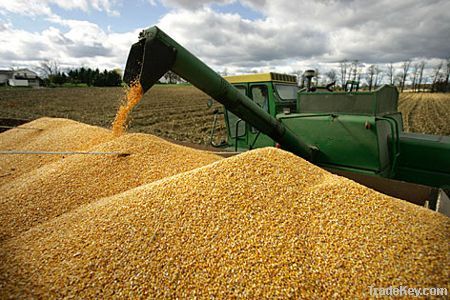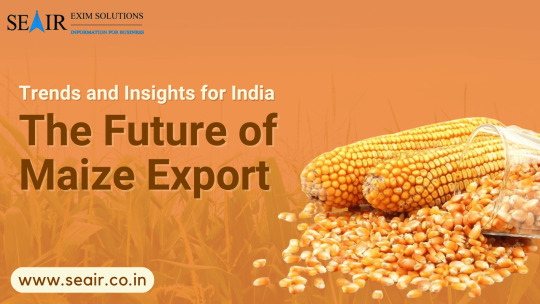#maize exporting countries
Text
Discover the latest trends in maize exports from India and learn how exporters can capitalize on the growing demand for maize-based products in the global market.
#export#import#trade data#import data#export data#international trade#global trade data#import export data#trade market#maize exports from India#maize exporters from India#maize exporting countries#Maize export data#maize hs code#India maize export#maize exporters
0 notes
Text
Europe’s never-ending struggle to provide tidbits of assistance to Ukraine while still pandering to the agricultural lobbies that dictate so much policy in Brussels took another tortured turn this week. The European Commission hammered out its latest, tentative compromise plan to offer Kyiv another year of tariff-free access to the European single market for some agricultural products—but it’s not a done deal, and it could end up as a nasty tripwire for Ukraine’s hopes to join the European Union.
At issue is a monthslong tussle over the renewal of tariff-free access for a handful of Ukrainian farm goods, such as eggs, poultry, honey, and maize (corn). Ukraine, which is not a member of the EU and is in the middle of a war with Russia, desperately wants the trade relief, which it figures is worth well over 1 billion euros a year in much-needed export earnings.
Europe as a whole is unlikely to be concerned about such rounding-error figures, but certain groups in Europe—namely farmers in eastern “front-line” countries—care very much indeed. Farmers in Poland have added angry chants against Ukrainian food imports to the standard-issue complaints about the European Green Deal and free trade that animate farmer protests across the continent; they’ve even blocked the borders east and west in protest against what they say is a flood of outside food that is undermining their livelihood.
In a nutshell, Europe’s bid to offer Ukraine the tiniest of economic lifelines is threatening to weaken support for the country’s eventual membership in the EU by angering groups with outsized political influence that feel threatened by what looks to them like the stealth arrival of a new trade rival. That is most evident in Poland, Ukraine’s neighbor, which when the war began was hugely supportive of aiding Kyiv in any way possible but which in recent months has become a lot more sour on defense assistance, Ukrainian refugees, Ukrainian wheat, and, of course, Ukrainian EU membership.
According to recent opinion polls, support among Poles for further aid to Ukraine is dropping sharply, and that is especially true among more right-wing voters (as is true across much of Europe). One big reason for this decline in support is the fight that Polish farmers have waged against what they see as a flood of cheap, foreign food.
“What I can say is that the support for Ukraine has taken a real hit in Poland. Look at enlargement, support for refugees, even weapons,” said Isabell Hoffmann, a survey expert at Eupinions, an independent platform for European public opinion. “Support was extraordinarily strong before, and it is still strong today. But it weakened notably and quickly.”
Poland has been fighting over Ukrainian food imports for a year, but the protests intensified at the beginning of this year with further border blockages and anti-Ukraine animus which have found widespread popular support.
“This issue has become very toxic in domestic politics. There are more and more critical voices in Poland,” said Piotr Buras, the head of the Warsaw office of the European Council on Foreign Relations (ECFR). “This is the paradox: The European Commission is talking about more gradual integration with Ukraine and the single market, but we are talking about the gradual closing of the single market for Ukraine.”
All this began, like so many of Ukraine’s current woes, with the full-scale Russian invasion in early 2022, which threatened Ukraine’s breadbasket agricultural regions and, importantly, its main export route through the Black Sea. The EU offered emergency tariff relief for a host of Ukrainian agricultural goods so they could travel overland and into the EU and trade without prejudice.
For Ukraine, desperate to earn foreign currency and boost the few exports that were left after the Russian invasion, it was a tidy little lifeline.
“From an economic point of view, agriculture remains one of the key export sectors of Ukraine,” said Marek Dabrowski, an expert on European trade and enlargement issues at Bruegel, a think tank. “Before the war, it was metallurgy and industry, but then part of that was destroyed, and part is occupied, so exports now are essentially down to agricultural goods. The reason for these ‘emergency measures’ has not gone away.”
Indeed, those emergency measures have continued every year since—until now. The European Commission planned to simply roll the tariff relief over this year, giving Ukraine one more year of free access, worth about 1.7 billion euros for Kyiv’s empty coffers. But many of the countries bordering Ukraine, including Hungary, Poland, and Slovakia, pushed back at what they viewed as a flood of cheap Ukrainian grain that was undermining their own farmers. Some countries, such as Poland, unilaterally blocked Ukrainian farm goods from staying in the country.
Together, and most recently backed by France, those countries pushed for a tougher version of tariff relief for Ukraine that would have limited the amount of agricultural goods it could sell to Europe. The European Commission and European Parliament have been at work hammering out ever-tougher versions of tariff relief ever since.
The latest proposal would still offer Ukraine relief for another year but with tougher quota baselines, which would cost Kyiv about 350 million euros annually. Ukraine’s farm lobby on Thursday decried the slide toward EU “protectionism” in the latest wrangling. But even that compromise measure still has to pass the European Parliament, where it could face yet further efforts to weaken Ukraine’s access.
While an extension, even a watered-down one, would still be welcome in Ukraine, the problem is the perception that such preferential trade policies create in front-line countries such as Poland. Ukrainian grain is not the cause for the plight of Polish farmers any more than it is the reason for angst in the countryside in the other 26 EU member states; that has a lot more to do with falling prices for global agricultural staples such as wheat, as well as slightly tougher (and costlier) EU regulations on agricultural production.
But many who are getting kicked while they are down don’t look carefully at precisely who is doing the kicking, and continual European assistance for Ukraine rubs many in the east the wrong way.
The temporary trade measures amounted to a full opening, Buras of ECFR said. “Basically, Ukraine jumped from a piecemeal opening to European access to the final stage of this process,” he said. “Nobody expected these measures to remain in place for three years or more. Technically, we have a full opening of the single market to Ukrainian products.”
The risk is that the tiny measures Europe is taking to shore up Ukraine today with trade relief could end up as a poisoned chalice in years to come. Once the war is over, Ukraine is widely expected to get on with its decade-long quest to become a member of the EU—a step that ultimately needs the go-ahead from all current member states.
“The Ukrainians should also, seen from Warsaw, be a little more careful when they push for more liberalization,” Buras said. “At the end of the day, Ukrainians are dependent on Polish support” to join the EU, he added.
6 notes
·
View notes
Text



September 17th 1873 saw the death of Scottish born surgeon, merchant, explorer and settler Alexander Berry.
Berry was born on 30 November 1781 in Fife, Scotland, one of nine children of James Berrie (d.1827) and his wife Isabel Tod (d.1830). He was educated at Cupar Grammar School and at the Universities of St Andrews and Edinburgh where he studied medicine. Despite his father's opposition he became surgeon's mate in an East Indiaman bound for China and later in the Lord Hawkesbury on a voyage to Madras. His dislike of the flogging of seamen and a recognition of the profit to be won from commerce led him to abandoned his chosen profession.
From 1808 made several voyages to New South Wales with cargos of goods. Travelled to South America and returned to London in 1812, after losing his ship. In 1819 returned to Sydney establishing a mercantile business in partnership with Edward Wollstonecraft. In 1822, Berry and Wollstonecraft applied for a grant of 10,000 acres on the Shoalhaven River in New South Wales. In 1823 they exported coal to Rio de Janiero. Closed their mercantile business in 1828. In 1830 a grant of land of 10, 000 acres applied for on the Shoalhaven in 1822 was approved. Between 1830 and 1840 he purchased an additional 22,000 acres which produced maize, tobacco, wheat, barley, potatoes, pigs and cattle. The area had some of the most fertile and lush farmland in the country.
Berry grew very wealthy from his occupation. He sat in NSW parliament for 14 years and is considered a founding father of the area; they named the town after him in 1888.
This settlement became known as the Coolangatta Estate and developed into what is now the pretty and historic township of Berry , named in honour of Alexander and his brother, two hours south of Sydney It is a popular tourist spot, especially among the short-stay and weekender crowd.
Of course with the majority of Colonial rule Alexander’s success came at a price to the native population.
Berry used Aboriginal people as slave labour to clear the land – whether you consider payment by way of rations as slave labour – but there definitely wasn’t a monetary exchange.
Berry had a different view, but more and more these colonial settlers are being uncovered what for what they were. this was what he had to say in his memoirs;
“For many years I have reaped my harvest on the principle of free Labour. When I made a settlement at Coolangatta, in 1822, [Aboriginal people] were comparatively numerous, and were said to be very ferocious. I was informed that they had recently driven away a number of sawyers or wood-cutters, and my old friend, the late James Norton, told me that they would eat me. I had, however, served a kind of apprenticeship to the management of savages in New Zealand, and I was always on good terms with those of the settlement. Indeed, I found them very useful.”
As well as using the indigenous population he is also accused of raiding the graves of those people in the name of scientific research for the likes of Charles Darwin and others back home in good old “Blighty”
Australian researchers say they have uncovered evidence from Berry’s correspondence and his later reminiscences that he sent the skull of the Yuin leader Arrawarra to Britain in 1827, two years after he died.
We Scots can’t just wash our hands of all this, as well as Berry being a Scot we were involved at the other end, where the skull ended up, a letter of 20 August 1827 indicates Berry dispatched the skull, probably to the Edinburgh Museum, although it has not yet been found.
He was also involved, after the fact of the Boyd massacre, where Maori residents of of Whangaroa Harbour in northern New Zealand killed between 66 and 70 European crew of the Boyd. The massacre itself is said to have been in retaliation of floggings of Maori’s on the vessel. Brery took two local chiefs hostage for a time. He wrote in the Edinburgh Magazine that he had released them on condition that they lose their rank with their people, although he never expected that to happen.
Berry's memoirs were published in 1912, entitled 'Reminiscences'.They chiefly describe his experiences at sea, both with the East India company and his private travels, with only a short section covering his life in New South Wales. In particular he describes in detail his relationships with the indigenous people of New Zealand and Fiji, and his experiences during the rescue at the scene of the Boyd massacre.
Alexander Berry died on this day 1873 aged 91, at Crows Nest House. He was buried in family vault in St. Thomas' cemetery with his wife, Elizabeth Wollstonecraft, who was cousin of the Frankenstein author Mary Shelley.
While some admire Berry as a pioneering hero he has also been described as an “Immoral Hero”
10 notes
·
View notes
Text
Brazil may surpass United States as world's number one corn exporter
Brazilian corn production should set a new record in 2023, allowing the country to become the world's leading exporter of maize, ahead of the United States.

On his farm in the state of Mato Grosso, Brazil's grain basket, Ilson Jose Redivo finished planting his corn crop a few weeks ago, acting quickly once he'd harvested the soybeans that he'd grown on the same fields.
In this region of west-central Brazil, the fields stretch as far as the eye can see and the schedule is well established: The farmer plants the two crops, soybean and maize, on "almost 100 percent" of his over 1,550 hectares (3,800 acres). The corn will be harvested in June.
The maize is a second crop, or "small crop," which Brazilians call a "safrinha." Over the past decade, the second crop has turned into Brazil's main corn crop and taken an increasing share of world maize production.
This year's expected production should hit a record, making Brazil the world's leading corn exporter ahead of the United States, a position it has only reached once before, in 2013.
Continue reading.
7 notes
·
View notes
Text
Vietnam Cattle Feed Market: Dairy Cattle to Remain Dominant through 2028

Growing demand for animal protein and increasing awareness of animal welfare is expected to drive the growth of Vietnam Cattle Feed Market in the forecast period, 2024-2028.
According to TechSci Research report, “Vietnam Cattle Feed Market - By Region, Competition Forecast and Opportunities, 2018-2028,” the Vietnam Cattle Feed Market is anticipated to grow at a steady rate in the forecast period, 2024-2028. The Vietnam cattle feed market is a rapidly growing industry, driven by a combination of factors such as rising demand for animal protein, increasing industrialization of livestock production, and the need for improved feed quality and nutrition.
Vietnam is one of the fastest-growing economies in Southeast Asia, and its livestock sector has grown significantly over the past decade. The country is a major exporter of livestock products, including meat and dairy products, and has seen significant investments in feed production and processing.
The market for cattle feed in Vietnam is dominated by a few large players, with most of the feed production concentrated in the southern part of the country. The main types of feed produced in Vietnam are concentrate feed, forage, and mixed feed. Concentrate feed is the most popular type, as it contains a high concentration of nutrients and is suitable for feeding cattle in confined systems.
The Vietnam Cattle Feed Market can be segmented by animal type, by ingredients, by region and competitive landscape.
The Vietnam Cattle Feed Market can be divided into Dairy Cattle, Beef Cattle, Others, based on animal type. Dairy Cattle segment is expected to grow in the forecast period owing to the growing demand for dairy products, higher profitability, government support, increased investment in dairy feed production, and improved genetics. As the Vietnamese population becomes more affluent, there is a growing demand for dairy products such as milk, cheese, and yogurt. This has led to an increase in the number of dairy farms and the need for more dairy cattle.
Browse over XX market data Figures spread through 70 Pages and an in-depth TOC on "Vietnam Cattle Feed Market"
https://www.techsciresearch.com/report/vietnam-cattle-feed-market/15203.html
Dairy cattle are generally more profitable than beef cattle because they produce milk, which can be sold for a higher price than beef. In addition, dairy cattle can be milked for several years, while beef cattle are typically sold after one or two years. With the growing demand for dairy products, there has been an increase in investment in dairy feed production in Vietnam. This has led to the development of new feed formulations and technologies that are specifically designed for dairy cattle.
The Vietnam Cattle Feed Market is divided into Corn, Soyabean Meal, Wheat, Oilseeds, Additives, Others, based on ingredients. The Corn segment is expected to acquire the largest share in the coming years due to availability of raw materials, nutritional value, high demand, and stable prices. Corn is one of the most widely used ingredients in cattle feed production, and its demand is expected to continue to grow as the livestock industry expands in Vietnam.
This is particularly true for the dairy cattle segment, which requires a high-energy diet to maintain milk production. Corn can be used in a variety of feed formulations, from concentrate feeds to forage and mixed feeds. It can be utilized in various kinds of cattle feed. Energy-dense maize is a great source of fiber, protein, and other vital nutrients. It provides the necessary energy for cattle to grow and maintain their body weight, making it a critical component of cattle feed.
The Vietnam Cattle Feed Market is divided into Northern, Central, Southern, based on region.
Major companies operating in Vietnam Cattle Feed Market are:
CJ Vina Agri Co., Ltd.
C.P. Vietnam Corporation
GreenFeed Vietnam Corporation
Anova Feed Joint Stock Company
Dabaco Group Joint Stock Company
Hoang Long Livestock Production One Member Limited Liability Company
Mavin Group Joint Stock Company
De Heus Animal Nutrition Vietnam
BASF Vietnam Co., Ltd.
Cargill Vietnam
Download Free Sample Report
https://www.techsciresearch.com/sample-report.aspx?cid=15203
Customers can also request 10% free customization in this report.
“The Vietnam cattle feed market is a rapidly growing industry, driven by increasing demand for animal protein. The adoption of precision fermentation technology and expansion of the dairy industry are also key trends in the market. However, the high production costs, feed quality and safety issues, and limited availability of raw materials pose significant challenges to the industry.
Nevertheless, with investments in research and technology, and the development of the supply chain, the Vietnam cattle feed market presents significant growth opportunities for producers and investors.” said Mr. Karan Chechi, Research Director with TechSci Research, a research based global management consulting firm.
“Vietnam Cattle Feed Market By Animal Type (Dairy Cattle, Beef Cattle, Others), By Ingredients (Corn, Soyabean Meal, Wheat, Oilseeds, Additives, Others), Region, Competition Forecast & Opportunities, 2018-2028F,” has evaluated the future growth potential of Vietnam Cattle Feed Market and provides statistics & information on market size, structure, and future market growth. The report intends to provide cutting-edge market intelligence and help decision makers take sound investment decisions. Besides, the report also identifies and analyzes the emerging trends along with essential drivers, challenges, and opportunities in Vietnam Cattle Feed Market.
Browse Related Research
UAE Vertical Farming Market
https://www.techsciresearch.com/report/uae-vertical-farming-market/10654.html
UAE Fertilizer Market
https://www.techsciresearch.com/report/uae-fertilizer-market/10671.html
UAE Pesticides Market
https://www.techsciresearch.com/report/uae-pesticides-market/14703.html
Contact
Mr. Ken Mathews
708 Third Avenue,
Manhattan, NY,
New York – 10017
Tel: +1-646-360-1656
Email:[email protected]
Website: https://www.techsciresearch.com
#Vietnam Cattle Feed Market#Vietnam Cattle Feed Market Size#Vietnam Cattle Feed Market Share#Vietnam Cattle Feed Market Trends#Vietnam Cattle Feed Market Growth
0 notes
Text
GRAINS-Wheat rises 1% on global supply woes, Brazilian floods support soy prices SINGAPORE, May 20 (Reuters) - Chicago wheat futures bounced back on Monday, with the market climbing 1% as worries over production decline in several exporting countries, including top supplier Russia, supported prices. Soybeans were largely steady after a rally, as crop losses in Brazil following rains and heavy flooding continued to underpin the market. FUNDAMENTALS The most-active wheat contract on the Chicago Board of Trade (CBOT) Wv1 was up 1% at 6.57-1/2 a bushel, as of 0016 GMT, having lost 1.8% on Friday. Soybeans Sv1 almost flat at $12.27-3/4 a bushel and corn Cv1 added 0.4% to $4.54-1/2 a bushel. Adverse weather in Russia and European countries in supporting wheat prices. Russia's wheat exports in the 2024/25 season could amount to 46.9 million metric tons, according to a consensus forecast by the Russian Union of Grain Exporters. The agriculture ministry estimated wheat exports for the 2022/23 season at 47 million tons. The condition of French soft wheat crops steadied at a four-year low last week while maize planting accelerated, data from farm office FranceAgriMer showed on Friday, after a warm spell helped rain-soaked fields dry out. For soft wheat, 64% of the crop was estimated to be in good or excellent condition by May 13, unchanged from the previous week but down from 93% a year earlier, FranceAgriMer said in a cereal crop report. Germany's winter wheat area for the 2024 harvest has been reduced by 8.3% year-on-year to about 2.6 million hectares, the country's national statistics agency estimated on Friday. However, improved crop prospects in the United States could limit gains in CBOT futures. The Wheat Quality Council's annual crop tour concluded on Thursday and estimated Kansas wheat's yield potential at 46.5 bushels per acre (bpa) after scouting 449 fields over three days. The figure was the highest since 2021 and above the five-year tour average of 42.4 bpa from 2018-2023. Last week, soybeans rose as crop harvesting in Brazil's flood-devastated Rio Grande do Sul advanced slowly in the last week after relentless rains and stubbornly high waters failed to subside. Excessive rains and heavy flooding have continued to constrain cargo movement at Rio Grande port, which is the fourth largest in the country for soybean exports and third largest for fertilizer imports. Large speculators trimmed their net short position in CBOT corn futures in the week ended May 14, regulatory data released on Friday showed. The Commodity Futures Trading Commission's weekly commitments of traders report also showed that non-commercial traders, a category that includes hedge funds, trimmed their net short position in CBOT wheat and increased their net short position in soybeans. MARKET NEWS A world stock index rose for a seventh straight session and U.S. Treasury yields also gained as investors tried to assess the timing of potential interest rate cuts by the Federal Reserve this year.
0 notes
Text
Zambia (Economy)
Zambia (Economy)
Copper Industry: Zambia’s economy is heavily dependent on the copper mining industry, which accounts for a significant portion of the country’s GDP and exports. However, fluctuations in global copper prices can impact the economy.
Agriculture: Agriculture is another important sector, employing a majority of the population. Key crops include maize, tobacco, cotton, sugarcane,…
View On WordPress
0 notes
Text

Breaking News
⇝ Samantha undergoes hyperbaric therapy - Times of India
⇝ Aman Gupta misses his chance of getting a selfie with PM Narendra Modi; writes, "I kept folding my hands even after he left" - Times of India
⇝ Brazilian dictionary adds Pele as adjective, synonym of 'best' | Football News - Times of India
⇝ Shibpur: Calcutta HC orders NIA probe into violence in Shibpur during Ram Navami | India News - Times of India
⇝ Sudan crisis: No Indian will be left behind, constantly monitoring situation, MEA says | India News - Times of India
⇝ Shiv Thakare offers prayers at Siddhivinayak temple ahead of Khatron Ke Khiladi 13; says his aai is scared of his participation - Exclusive! - Times of India
Home
Agency News
Start Up Siddhiprad to focus on Health Essentials by dedicating to improve Human Health with Health Care Products.
Agency News
Start Up Siddhiprad to focus on Health Essentials by dedicating to improve Human Health with Health Care Products.
by cradminApril 15, 2024054
SHARE0

New Delhi: 14th April 2024. Siddhiprad®, a vitamin and supplement brand, announced today the launch of six new products to their health Care line: Vitamin C for Daily Energy†, Multivitamin for Daily Immune Support†, Ashwagandha for Daily fatigue Support†. and Green Fit for Daily Stress Support†. Siddhiprad main focus is on improving Human Health which is becoming challenge after kovid pandemic. Immune, Energy & Stress are becoming concern and required Quality Health Essentials to maintain good health. Siddhiprad Startup Steps Up in Health Essentials Amid Pandemic Crisis. Committed to enhancing human health, Siddhiprad focuses on delivering quality healthcare products. With concerns rising over immunity post-pandemic, the startup aims to address health challenges with affordable solutions. Co-founded by Purnima and Dr. Devvrat, the venture introduces six meticulously chosen products in the Health and Personal Care category with Immune, Energy and Stress Support. Dr. Devvrat’s personal involvement ensures product excellence, tackling the challenge of providing quality at accessible prices. Siddhiprad pledges to continue its mission, promising more innovative products in the pipeline to safeguard public health.
“Even as societal trends lean further into proactive health and wellness, it can be hard in today’s fast-paced world to consume all vitamins and minerals necessary for our bodies to function at their best – and prioritizing supplementation every day can be difficult, especially if the experience isn’t pleasant,” says Dr. Devvrat Raghuvanshi, Director at Siddhvidhya.
“We know that missing a dose likely means nutrient gaps aren’t closed that day, so we aim to encourage more consistent intake with product formulations that are nutrient-packed, enjoyable, and supportive of differing health needs. There is always a big challenge to provide Quality Product’s with affordable price. Dr. Devvrat was Personally involved into development of each product. Start Up Siddhiprad will bring many more such products in Near future.
About Siddhiprad
Siddhiprad is the leading vitamin and supplement broadline brand, with expertise of delivering high quality products that are backed by science. Aiming to become as the #1 Recommended vitamin and supplement brand*, Siddhiprad meet quality criteria for purity and potency.
Visit for the latest offering at siddhiprad.com and follow us on Facebook (@siddhvidhyaagro), YouTube (@siddhiprad), wattpad (@siddhiprad), Threads(@siddhiprad), Instagram (@siddhiprad.official), Pinterest (@siddhiprad) and Blogger (@siddhiprad)
https://www.amazon.in/stores/page/4EA4708D-A655-423E-9670-85F1D7F7C426?ie=UTF8&field-lbr_brands_browse-bin=SIDDHIPRAD&ref_=cm_sw_r_apann_sf_stores_J13QSQYP81TA7TJP2W2S
About Siddhvidhya Agro India Pvt. Ltd.
Siddhvidhya is a Fast growing in the field of cultivations of organic vegetables. Export business of Rice and Maize to east African countries. Developing & Marketing products in the health and wellness industry, earning the trust of consumers, healthcare professionals and retailers by developing innovative vitamin and supplement solutions backed by science that adhere to strict manufacturing practices. Through its Siddhiprad@ brand, Siddhvidhya is dedicated to helping people live healthier, more vital lives. Based in Geater Noida (Delhi NCR), Visit at Siddhvidhya.com

0 notes
Text
Choose a Reliable Dehydrated vegetables Suppliers in India
Are you looking for a best quality dehydrated vegetables that is fully developed organically with all natural procedures then surely AYS International is your ideal destination. They are one of the pioneer names among the fraternity of all the leading dehydrated vegetables suppliers in India that offers best in class quality all dehydrated vegetable products to the end customer at a much affordable cost.
Since from the time of their inception they have been offering all best quality dehydrated products that comes to you at a fraction of cost. As they are in this industry for the last few decades the company has got a huge experience in working in this industry. Here you can expect to get all premium quality fully organic dehydrated vegetables of all times.

Well, they have a well-maintained team of all highly experienced professional who always remains ready to offer all kinds of support to their customers based on their queries regarding their dehydrated products which they are selling. Here whatever sorts of queries they have in their minds they will get it solved as early as possible.
The company provides all kinds of dry vegetables in full organic way so that the customers get the best quality dehydrated product at an affordable cost. Here they provide various range of organic dehydrated vegetables that are being manufactured through complete natural process.
And the best part is that all these dehydrated products come to you at a much affordable cost that both suits to your budget as well as meets your requirements. Since from the time of their inception the company has been there in this industry and providing customers with the best support solution at an affordable cost.
They are one of the biggest sellers as well as distributer of all kinds of dehydrated vegetables where we export most of these products to countries like Dubai and all other middle east countries across the globe. So, if you are living in abroad then also you can place your order after seeing our range of products from our official website.
Now once you are done completing your research you can place your order straight from the website and in this regard if you have any sorts of queries then you can get it solved by speaking to our support team. Our team always remains ready to offer all kinds of help to our clients in this regard. Well, here we used to export different ranges of hydrated vegetables like hydrated garlic, onion, groundnut, maize, roasted peanuts, fried onions, along with other dehydrated vegetables and spices. So, for ordering our products just you need to visit our website and scroll through different list of dehydrated vegetables available there online.
Now once you choose anything then just place you order by a click of a button and you are done, it is as simple as that. Still if you face any sorts of problem then you can directly contact their support team who always remains ready to offer all kinds of help by solving all your queries on the go.
Apart from that here you will also get various ranges of dry vegetables that comes to you at a most affordable cost which both suits your budget as well as fills all your needs as well.
Well, here you will get a series of dehydrated vegetables like ginger flakes, tomato flakes, carrot flakes, beet flakes, potato flakes to name a few. So based on your requirements you can search from the website by exploring from the list of products given there.
In this case if you have anything to ask then you can directly interact with our team who will guide you in step-by-step manner to buy any dehydrated vegetables based on your requirements. All these has helped us emerge as one of the leading suppliers and manufacturer of all kinds of dehydrated vegetables that comes to you at a much cheaper price compare to competition.

So, visit our official website and browse through our various ranges of dehydrated products and place your order online based on your overall requirements that perfectly suits your budget as well a meet all your expectations and requirements.
#onion supplier#dehydrated onion supplier in india#dehydrated onion exporter#dehydrated vegetables#dehydrated product#dry vegetables
0 notes
Text

Maize Uganda’s Biggest Staple Foods
Maize is one of Uganda’s-Africa’s biggest staple foods and is consumed by almost every household within Uganda as a country and across East Africa. While white maize is the most consumed, Divine Grain Millers Uganda Ltd. is still producing the maize product each year in large quantities. This is because maize is great for both people and animals. However few people are aware of the benefits of maize. Maize is known to be nutritious although it has been given a bad reputation as being food for aid purposes especially here in Uganda East Africa.

Maize is nutritious and is filled with Vitamin A. This vitamin is somewhat lacking in the foods consumed throughout Africa, but is incredibly important in fighting off blindness and various diseases. The proof of its value lies in the healthy people who eat this meal as a staple part of their day to day diet.
According to Divine Grain Millers Uganda Ltd. Maize is not just for feeding people in Uganda, it is also a necessary food for livestock as observed largely in East Africa.
One of the biggest factors encouraging maize exporters to produce and distribute so much maize each year is that maize is a great food source for stock animals. Every part of the plant can be used for some purpose or other. The cob itself is usually harvested for human consumption but the stalks can be fed to animals while surplus grain can be used to feed poultry.
0 notes
Text
Navigating Supply-Demand Dynamics in the Potash Fertilizers Market

Potash Fertilizers: Exploring the Vital Role in Agriculture and its Influence on Food Production
What is Potash?
Potash refers to various mined and manufactured salts that contain potassium in water-soluble form. Potassium is one of the three primary macronutrients used in fertilizers, along with nitrogen and phosphorus. Potash exists both as minerals and salts, with the most common being potassium chloride, otherwise known as muriate of potash. It is predominantly used as a fertilizer for agriculture.
Role of Potassium in Plant Growth
Plants require potassium to perform important functions in their growth cycle. Potassium regulates processes like photosynthesis, translocation of sugars, enzyme activation and protein synthesis within plants. It improves the ability of plants to absorb and retain nutrients efficiently, making them more resilient to stresses caused by drought, disease or frosts. Adequate potassium levels promote robust root development, strengthening the overall structure of plants.
Key Crops Benefitted by Potash Application
Potassium is especially important for high-yielding crops like cereals, fruits and vegetables. Some crops that benefit significantly from potash fertilization include:
Maize - Maize benefits tremendously from potash as it promotes stalk strength and drought tolerance in the crop. Potash application leads to higher yields of maize grains in many regions.
Wheat - Potassium maximizes the production of carbohydrates in wheat plants, boosting grain filling and yields. It improves grain size, protein content and milling qualities.
Rice - Potash application enhances panicle formation and grain development in rice. It enables rice crops to withstand biotic and abiotic stresses better.
Soybean - Potassium greatly influences nodule formation and nitrogen fixation in soybean plants. This leads to improved pod formation, seed quality and higher oil content in soybean.
Vegetables -Leafy greens and root vegetables like tomatoes, potatoes and carrots absorb more potassium than other macro nutrients. Potash fertilizers are crucial for their growth, quality and shelf-life.
Role in Improving Food Security
Global population is expected to rise to nearly 10 billion by 2050, placing enormous pressure on the agricultural sector to increase food production substantially. The plant-available forms of potash from fertilizers play a critical role in boosting yields to meet escalating food demand. Research shows potash application led to yield gains ranging from 10% for wheat to 67% for potatoes in different regions. By bridging existing crop yield gaps, potash fertilizers can potentially increase overall global food output by 278 million tons according to studies. This mitigates food insecurity issues and eases supply chain constraints caused by geopolitical tensions.
Importance of Maintaining Soil Potassium Levels
Soil testing and balanced fertilization practice are vital to maintain adequate potassium levels in cultivable land. Continuous cropping and exhaustive crop harvesting deplete soil potassium over time if not replenished through fertilizers. Low potassium levels impair crop vigor and render plants susceptible to diseases and environmental stresses. This impacts both yield and quality negatively. Maintaining a minimum recommended potassium level based on soil type is advisable to sustain long-term productivity and profitability of farms. Balanced potash nutrition also helps to optimize usage of other agro inputs for maximizing returns on investment. Furthermore, potassium recycling with crop residues sustains a balanced nutrient budget in the soil.
Concerns over Potash Supply and Price Volatility
Top potash producing countries are located in politically sensitive regions and production is dominated by a few large companies and state-owned enterprises. Geopolitical tensions or changes in export policies have previously led to significant supply disruptions and price spikes in the global potash market. Nearly two-thirds of global potash reserves are situated in Canada and Russia alone. Potassium chloride reserves in other major producers like Belarus, Germany and Israel will only last for a few more decades at current production rates. Mounting global fertilizer demand has increased dependency on supplies from regions like Canada with large unexploited reserves that are also environmentally challenging and capital intensive to tap. This supply insecurity coupled with monopoly pricing power of select producers makes long term potash access an uncertainty for many importing countries dependent on international trade. Food security concerns arise from unreliable potash availability and price volatility caused by such supply constraints.
0 notes
Text

Maize is an important crop in India, functioning as both a staple food and a source of biofuel, providing food security and supporting industrial demands. This blog delves into India's maize exports, covering export statistics, HS codes, and exporters.
Explore Blog: "The Future of Maize Export: Trends and Insights for India"
#maize exports from India#maize exporters from India#maize#Maize export data#maize exporters#maize exporting countries#maize hs code#maize production in India#largest producer of maize in India#India maize export#maize cultivation in India#maize importing countries from India#import#export#import export data#global trade data#international trade#trade data#trade market
0 notes
Text

Long ago A clan of fruit bats were forced to drink the blood of a god to protect their lands from invasion and were transformed into soucouyant.They fully transformed were blessed with dark magic and shape shifting abilities and was victorious against the invaders.They became the first vampires.They established the kingdom of Jada. Kaleisha Vea Gillain is the descendant of these vampires and wants to keep her people safe.she has an unquenchable wanderlust. She is Curious and sweet by nature, if not a bit jumpy.
She’s from the kingdom of Jada which resides in the country of woodwater.the capital is Fayard town. They export sugar cane,indigo,cocoa, beer,rum,cassava,sea almonds,sweet potato,maize,and animal hides.it’s known for its reggae,tobacco,coffee,medicine,theaters,woodworking,metalworking,pirates
This kingdom and culture is based on ancient Jamaica
Note:her design is based of the Jamaican Fruit bat and the Ackee fruit.her body became poisonous due to eating the Ackee fruit all Her life.fruit bat colors are based off their diet.
#art#design#oc#designer#drawing#asthetic#characterdesign#myoc#mycharacter#jamaica#tropical#fantasy#princess#royalcore#magic#monster girl#fruit bat#vampire#folklore#fairytales#mythology#jewelry#commission are open#black girl art#blackgirlmagic#bat#claws#tail#wings#fangs
1 note
·
View note
Photo



September 17th 1873 saw the death of Scottish born surgeon, merchant, explorer and settler Alexander Berry.
Berry was born on 30 November 1781 in Fife, Scotland, one of nine children of James Berrie (d.1827) and his wife Isabel Tod (d.1830). He was educated at Cupar Grammar School and at the Universities of St Andrews and Edinburgh where he studied medicine. Despite his father's opposition he became surgeon's mate in an East Indiaman bound for China and later in the Lord Hawkesbury on a voyage to Madras. His dislike of the flogging of seamen and a recognition of the profit to be won from commerce led him to abandoned his chosen profession.
From 1808 made several voyages to New South Wales with cargos of goods. Travelled to South America and returned to London in 1812, after losing his ship. In 1819 returned to Sydney establishing a mercantile business in partnership with Edward Wollstonecraft. In 1822, Berry and Wollstonecraft applied for a grant of 10,000 acres on the Shoalhaven River in New South Wales. In 1823 they exported coal to Rio de Janiero. Closed their mercantile business in 1828. In 1830 a grant of land of 10, 000 acres applied for on the Shoalhaven in 1822 was approved. Between 1830 and 1840 he purchased an additional 22,000 acres which produced maize, tobacco, wheat, barley, potatoes, pigs and cattle. The area had some of the most fertile and lush farmland in the country.
Berry grew very wealthy from his occupation. He sat in NSW parliament for 14 years and is considered a founding father of the area; they named the town after him in 1888.
This settlement became known as the Coolangatta Estate and developed into what is now the pretty and historic township of Berry , named in honour of Alexander and his brother, two hours south of Sydney It is a popular tourist spot, especially among the short-stay and weekender crowd.
Of course with the majority of Colonial rule Alexander’s success came at a price to the native population.
Berry used Aboriginal people as slave labour to clear the land – whether you consider payment by way of rations as slave labour – but there definitely wasn’t a monetary exchange.
Berry had a different view, but more and more these colonial settlers are being uncovered what for what they were. this was what he had to say in his memoirs;
“For many years I have reaped my harvest on the principle of free Labour. When I made a settlement at Coolangatta, in 1822, [Aboriginal people] were comparatively numerous, and were said to be very ferocious. I was informed that they had recently driven away a number of sawyers or wood-cutters, and my old friend, the late James Norton, told me that they would eat me. I had, however, served a kind of apprenticeship to the management of savages in New Zealand, and I was always on good terms with those of the settlement. Indeed, I found them very useful.”
As well as using the indigenous population he is also accused of raiding the graves of those people in the name of scientific research for the likes of Charles Darwin and others back home in good old “Blighty”
Australian researchers say they have uncovered evidence from Berry’s correspondence and his later reminiscences that he sent the skull of the Yuin leader Arrawarra to Britain in 1827, two years after he died.
We Scots can’t just wash our hands of all this, as well as Berry being a Scot we were involved at the other end, where the skull ended up, a letter of 20 August 1827 indicates Berry dispatched the skull, probably to the Edinburgh Museum, although it has not yet been found.
He was also involved, after the fact of the Boyd massacre, where Maori residents of of Whangaroa Harbour in northern New Zealand killed between 66 and 70 European crew of the Boyd. The massacre itself is said to have been in retaliation of floggings of Maori’s on the vessel. Brery took two local chiefs hostage for a time. He wrote in the Edinburgh Magazine that he had released them on condition that they lose their rank with their people, although he never expected that to happen.
Berry's memoirs were published in 1912, entitled 'Reminiscences'.They chiefly describe his experiences at sea, both with the East India company and his private travels, with only a short section covering his life in New South Wales. In particular he describes in detail his relationships with the indigenous people of New Zealand and Fiji, and his experiences during the rescue at the scene of the Boyd massacre.
Alexander Berry died on this day 1873 aged 91, at Crows Nest House. He was buried in family vault in St. Thomas' cemetery with his wife, Elizabeth Wollstonecraft, who was cousin of the Frankenstein author Mary Shelley.
While some admire Berry as a pioneering hero he has also been described as an “Immoral Hero”
10 notes
·
View notes
Text
EU tariffs on Russian grain imports have no significant impact
The introduction of high tariffs on Russian grain imports to the EU will have little or no impact as the volume of Russian grain entering the EU is very low and is not worth a lot of money, according to bne IntelliNews.
The European Commission proposed a tariff of 95 euros per tonne on grain imported from Russia and Belarus, with the plan being discussed at an EU summit in Brussels on 22 March.
The measure is aimed at preventing potential market destabilisation by keeping out large volumes of grain from Russia, which has had record-high harvests for several years. However, the tariff hike will have little or no impact on Russia, as a senior EU official noted that the nearly 5 million tonnes of annual grain exports from Russia to the EU represented only 1% of the total EU grain market and were worth only €1.3 billion in 2023
Russia has long diversified its grain exports to the so-called friendly countries of the Global South. Russian grain exports in the 2023-2024 crop year could reach up to 65 million tonnes, President Vladimir Putin declared earlier this year.
Although the new grain tariffs will not have a significant impact, they, nevertheless, cover a wide range of grain products, including staples such as wheat, maize and sunflower meal. The European Commission stated:
The measures are designed to prevent EU market destabilisation through any future significant redirection of Russian grain products onto the EU market.
Read more HERE

#world news#world politics#news#europe#european union#european news#eu politics#eu news#russia#russia news#russia politics#russian news#russian politics#russian economy#grain#imports#exporter
0 notes
Text
Agriculture News Update: The Latest Developments in Nigeria's Farming Sector
Introduction: Nigeria's agricultural sector plays a vital role in the country's economy, providing livelihoods for millions of people and contributing significantly to food security and economic growth. Keeping abreast of the latest news and developments in the agricultural industry is essential for farmers, policymakers, and stakeholders alike. In this blog post, we'll explore the most recent updates and trends shaping agriculture News in Nigeria Today.

Government Initiatives and Policies: The Nigerian government continues to implement various initiatives and policies aimed at boosting agricultural productivity, enhancing food security, and promoting rural development. Stay informed about government programs such as the Anchor Borrowers Program, the Presidential Fertilizer Initiative, and the Agriculture Promotion Policy (APP) to understand their impact on farmers and agricultural practices nationwide.
Technological Advancements: Advancements in agricultural technology are revolutionizing farming practices in Nigeria, making them more efficient, sustainable, and resilient to climate change. Keep an eye out for news about innovative technologies such as precision agriculture, drone surveillance, and mobile applications that are empowering farmers with real-time data and insights to improve crop yields and manage resources more effectively.
Market Trends and Prices: Monitoring market trends and prices is crucial for farmers, traders, and consumers to make informed decisions about production, marketing, and purchasing agricultural products. Stay updated on commodity prices, market demand, and supply chain dynamics for key crops such as rice, maize, cassava, and cocoa to capitalize on market opportunities and mitigate risks.
Climate Change Resilience: Climate change poses significant challenges to Nigeria's agriculture sector, including unpredictable weather patterns, droughts, floods, and pest outbreaks. Stay informed about climate-smart agriculture practices, adaptation strategies, and resilience-building initiatives that are helping farmers mitigate the impacts of climate change and safeguard their livelihoods.
Youth Engagement and Empowerment: Engaging youth in agriculture is essential for the future sustainability of Nigeria's farming sector. Keep abreast of news about youth-led initiatives, training programs, and entrepreneurship opportunities that are encouraging young people to pursue careers in agriculture, innovate new solutions, and contribute to the development of rural communities.
International Partnerships and Trade: Nigeria's agricultural sector is increasingly interconnected with global markets and international trade agreements. Stay informed about bilateral and multilateral partnerships, trade negotiations, and export opportunities that are shaping Nigeria's position in the global agricultural economy.

Conclusion: Staying informed about the latest news and developments in Nigeria's agriculture sector is essential for driving innovation, fostering resilience, and unlocking the full potential of the country's farming industry. By staying abreast of government initiatives, technological advancements, market trends, climate change resilience efforts, youth engagement initiatives, and international partnerships, stakeholders can work together to build a more sustainable, inclusive, and prosperous future for Nigeria's agriculture sector.
0 notes